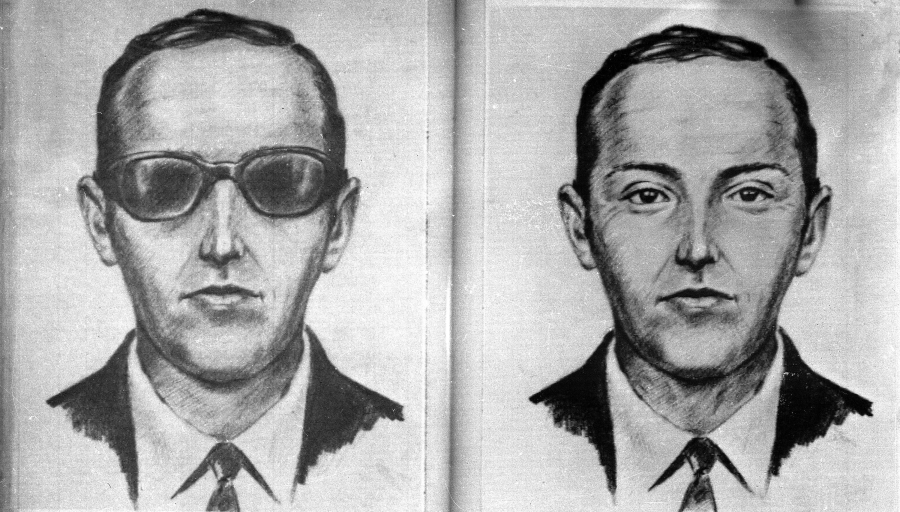It was “one of the longest and most exhaustive investigations” in FBI history — and to this day remains the only unsolved skyjacking in the United States.
In 1971, a well-dressed passenger hijacked a Northwest Orient flight, demanded $200,000 and later escaped by parachuting out of the back of the plane with the ransom money.
But who exactly was “D.B. Cooper,” the mysterious man who managed to pull off the heist and disappear without a trace?
More than four decades later, three amateur scientists think they may have found evidence that would narrow down Cooper’s identity to that of an aerospace engineer or a manager.
The scientists, working for a group called Citizen Sleuths, said they have been analyzing particles found on a clip-on necktie that Cooper left on his seat before jumping out of the plane.
To the naked eye, the piece of fabric was a nondescript black tie from J.C. Penney. But to the modern-day scientists, the tie was an “incredibly fortunate” piece of evidence in the investigation.
“A tie is one of the only articles of clothing that isn’t washed on a regular basis,” reads a section on the Citizen Sleuths website devoted solely to the tie. “It picks up dirt and grime just like any other piece of clothing, but that accumulation never truly gets ‘reset’ in the washing machine. Each of those particles comes from something and somewhere and can tell a story if the proper instruments like electron microscopes are used.”
Using a powerful electron microscope, the scientists say, they have identified more than 100,000 particles of “rare earth elements” on the tie, including pure titanium, according to the Associated Press.
“Titanium was a rare metal in 1971 and this makes it extremely unlikely it is a post-event contamination,” Citizen Sleuths notes on its site. “Its presence constrains Cooper to a limited number of managers or engineers in the titanium field that would wear ties to work.”
At the time, they noted, the element was used extensively by the military in aircraft and helicopters.
Scientists think he may have worked at Boeing, which at the time happened to be developing a Super Sonic Transport plane that used those elements, Tom Kaye, a lead researcher with Citizen Sleuths, told King 5 News.
“The tie went with him into these manufacturing environments, for sure, so he was not one of the people running these (manufacturing machines),” Kaye told the news station. “He was either an engineer or a manager in one of the plants.”
He added that the group was asking anyone from the public with information to contact researchers through the Citizen Sleuths website.
“Someone may be able to look at those particles and say, ‘Oh my gosh, I know what that means having those particles on the tie,’ ” Kaye told the news station.
The mystery began on Nov. 24, 1971, when a nondescript man going by the name of Dan Cooper purchased a one-way ticket from Portland to Seattle directly from the Northwest Orient Airlines counter on the day of the flight.
Authorities later described him as someone in his mid-40s, dressed as an “executive” in a suit, a white shirt and what probably is the now-infamous black tie.
The agency’s official summary of how the hijacking unfolded reads like the plot of a Hollywood thriller:
“He ordered a drink — bourbon and soda — while the flight was waiting to take off. A short time after 3:00 p.m., he handed the stewardess a note indicating that he had a bomb in his briefcase and wanted her to sit with him.
“The stunned stewardess did as she was told. Opening a cheap attach? case, Cooper showed her a glimpse of a mass of wires and red colored sticks and demanded that she write down what he told her. Soon, she was walking a new note to the captain of the plane that demanded four parachutes and $200,000 in twenty-dollar bills.
“When the flight landed in Seattle, the hijacker exchanged the flight’s 36 passengers for the money and parachutes. Cooper kept several crew members, and the plane took off again, ordered to set a course for Mexico City.
“Somewhere between Seattle and Reno, a little after 8:00 p.m., the hijacker did the incredible: He jumped out of the back of the plane with a parachute and the ransom money. The pilots landed safely, but Cooper had disappeared into the night and his ultimate fate remains a mystery to this day.”




